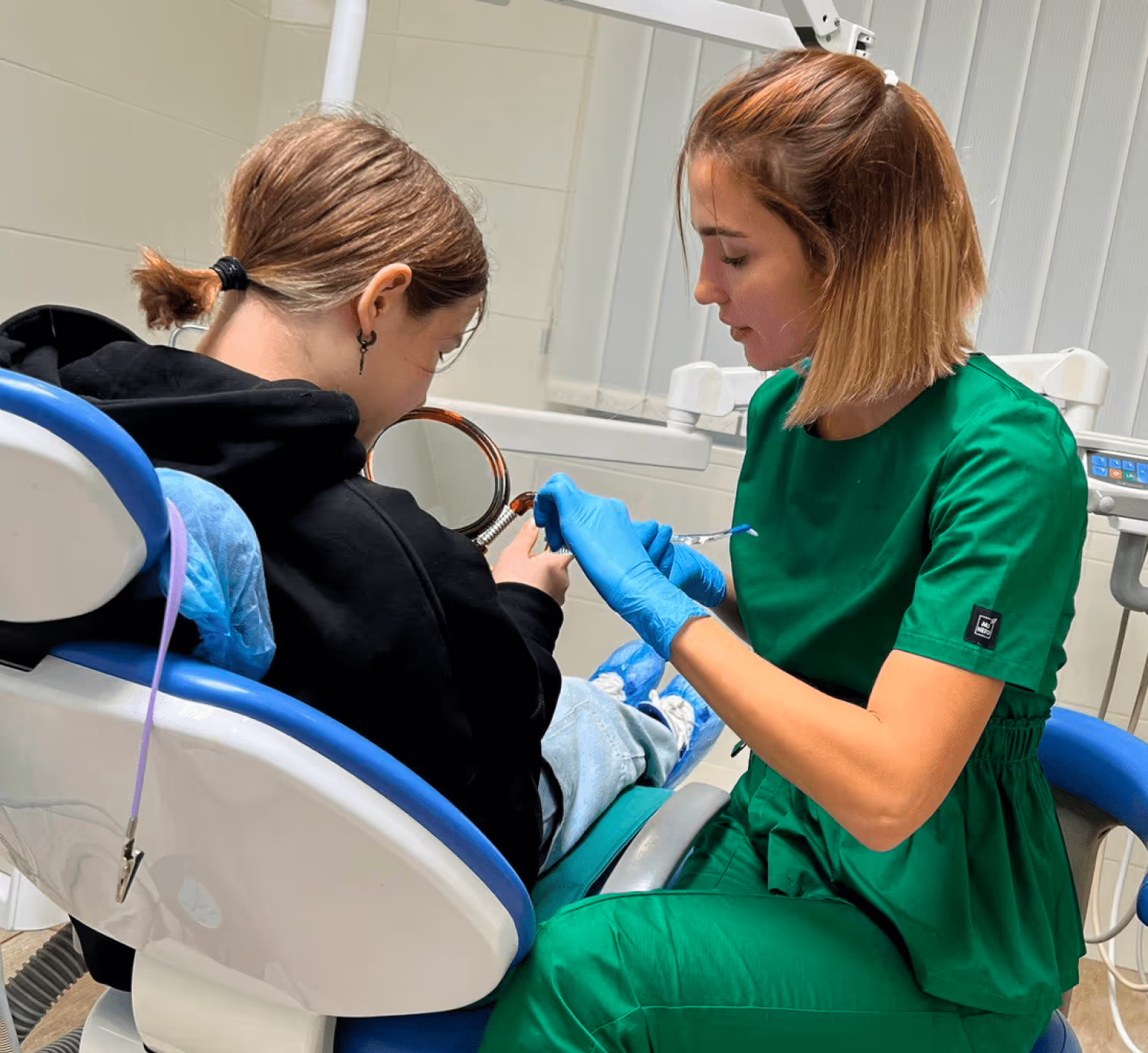The importance of orthodontic treatment
If teeth are not properly positioned, it can cause pain, discomfort, and problems with the jaw due to an uneven distribution of chewing load. Orthodontic treatment is also necessary for the health of the teeth themselves. For example, if teeth are tightly positioned or overlap each other, it creates complications in cleaning and caring for them, leading to an increased risk of tooth decay and oral inflammation.
It is important to consult with an orthodontist who will help to choose the optimal treatment method. At IODENT clinic, you can receive quality and professional orthodontic treatment.

Orthodontic treatment at IODENT clinic
Bite correction in children using plates
If a person has had problems with the development and growth of some teeth since childhood due to poor genetics, hygiene, or mechanical trauma, over time the condition of the upper or lower dental arch deteriorates. Orthodontic plates are used to solve such problems.
Orthodontic plates are a means of correcting the improper growth of teeth and the bite, which consist of a removable or non-removable polymer base and active elements, such as springs and arches. They are fixed in the oral cavity using rings, clamps, and other devices.
Usually, doctors recommend the installation of plates for children aged 6 to 11 years when intensive jaw development occurs. The main goal of treatment is to affect the growth of muscles, bones, and other hard tissues to form the correct closure of the jaws and lips and to correct the position of the teeth.
Depending on the treatment plan, plates solve various problems such as rotation or turning of teeth, widening of the jaw and creating space when it is deficient, replacing lost or extracted teeth. At IODENT clinic, orthodontic plates are custom-made for each patient, ensuring effectiveness and comfort during their wear.
Braces Systems: types and their differences
Braces are special systems used by orthodontists to straighten teeth and correct bites. They consist of several components, including brackets that are attached to teeth, an orthodontic archwire that aligns teeth and connects brackets, and ligatures or locks that connect the wire and brackets.
Metal braces - the most affordable type of braces, known for their high strength. They are highly effective in correcting misalignment, but they are visible on the teeth and may not be suitable for individuals concerned about aesthetics.
Aesthetic braces:
Ceramic braces — made of ceramic material, are highly durable. Their advantage is that the locks can be matched to the color of the tooth enamel. This makes the braces virtually invisible. However, this design is more expensive than metal braces.
Sapphire braces — are the latest development in aesthetic dentistry. They are made of artificially grown sapphire crystals, are invisible on teeth, hypoallergenic, and do not stain from food coloring. However, they are more expensive than other types of braces.
Two types of brace systems can be distinguished:
Ligature systems, use rubber ligatures to fix the wire to the brackets. In a ligature system, the orthodontist manually adjusts the force of the wire on the teeth.
Self-ligating systems, have special locks that automatically adjust the force of the brackets on the teeth. These systems work more efficiently and quickly.
Straightening the bite with the help of aligners
A dental cap, also known as an aligner, is a transparent, removable plate designed to align the teeth and correct the bite. The caps resemble a sleeve that fits over the teeth and effectively moves them into the correct position, forming a physiological bite. The process of correcting the teeth is painless. Each cap is worn for 2 weeks, after which it needs to be replaced with a new one.
An orthodontist models the correct position of the teeth and the number of aligners needed to treat the patient. Each cap constantly applies pressure to change their position to the required one. The doctor records the results during treatment and replaces the caps according to the plan. In this way, gradual alignment of the bite occurs, and the smile becomes even and attractive.
Advantages of aligners include:
- Easy to remove and clean on your own
- Invisible on the teeth
- Do not damage the enamel
- Do not cause a metallic taste in the mouth
- Have a smooth surface that is easy to get used to
- For correcting the position of the teeth, they need to be worn for only two hours a day and throughout the night (during sleep)
Retainer appliances
Retainer appliances or retainers are special devices used to secure the results after aligning teeth with braces. After you remove the braces and get a beautiful smile, your teeth, after their movement, may remain mobile for some time. Therefore, without retainer appliances, they may return to their previous position. To prevent this, doctors recommend wearing retainer constructions that can be removable or non-removable.
Non-removable retainers - are thin wires that are attached to the inside of the teeth. These appliances are more reliable and less noticeable than removable constructions. However, doctors more often prescribe removable appliances because they are easier to control the process of securing the teeth.


.avif)
.avif)

















